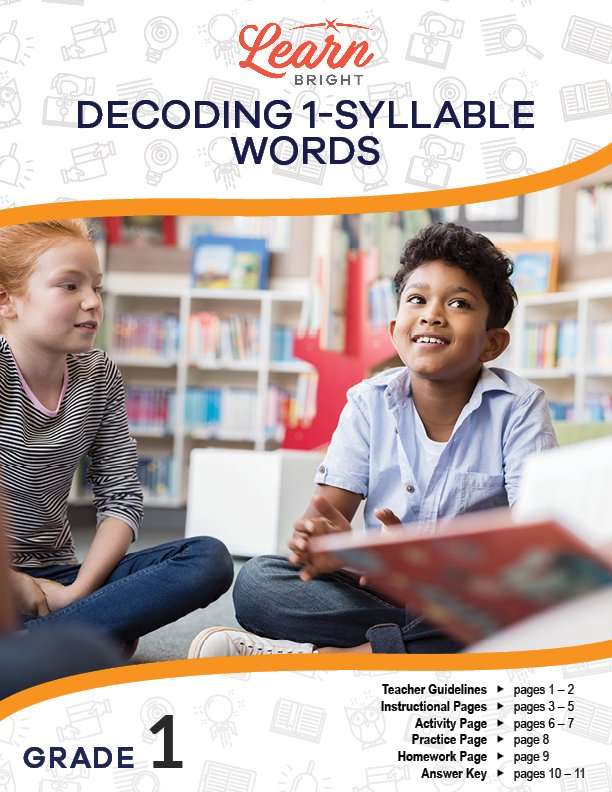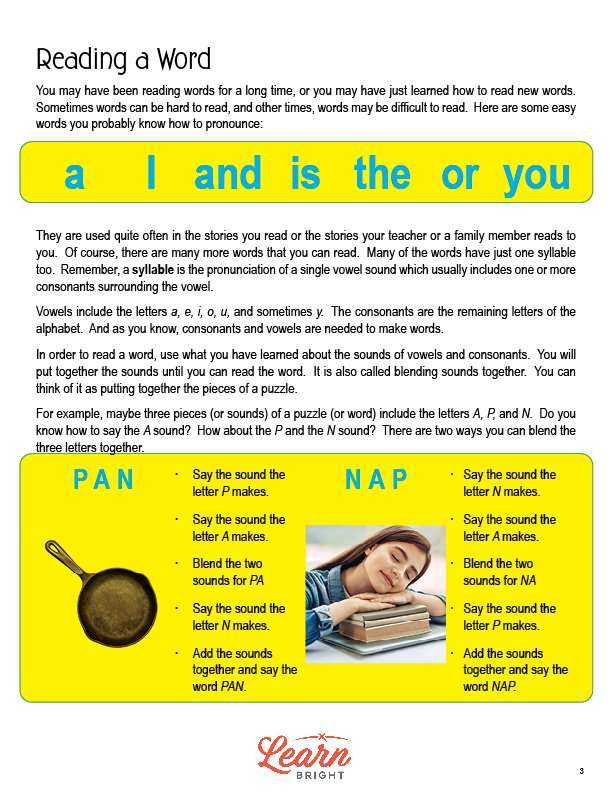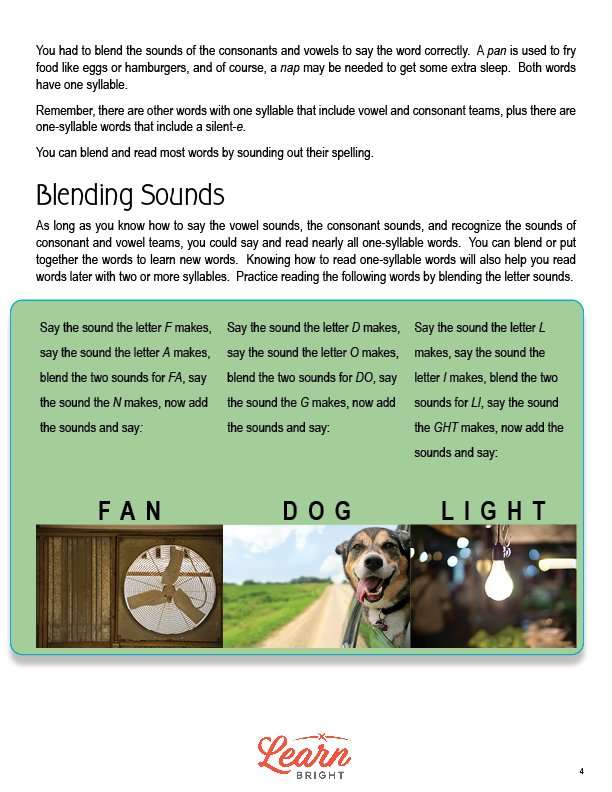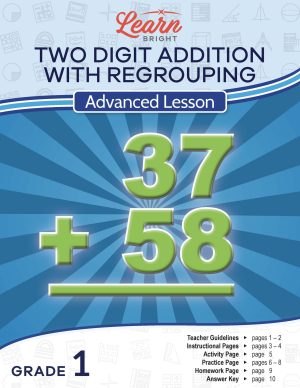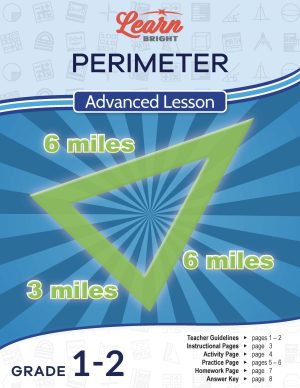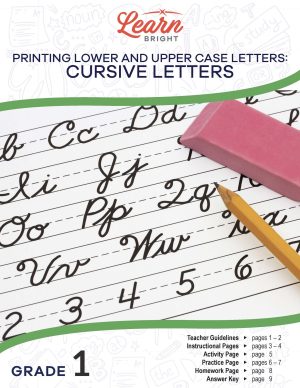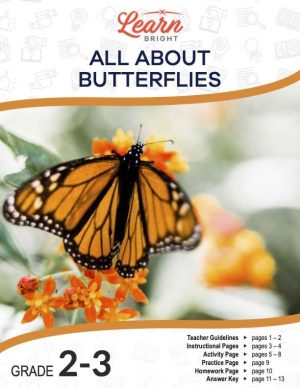Description
What our Decoding 1-Syllable Words lesson plan includes
Lesson Objectives and Overview: Decoding 1-Syllable Words teaches students strategies for reading and pronouncing 1-syllable words. At the end of the lesson, students will be able to decode regularly spelled one-syllable words. This lesson is for students in 1st grade.
Classroom Procedure
Every lesson plan provides you with a classroom procedure page that outlines a step-by-step guide to follow. You do not have to follow the guide exactly. The guide helps you organize the lesson and details when to hand out worksheets. It also lists information in the yellow box that you might find useful. You will find the lesson objectives, state standards, and number of class sessions the lesson should take to complete in this area. In addition, it describes the supplies you will need as well as what and how you need to prepare beforehand. The supplies you will need for this lesson are scissors and the handouts. To prepare for this lesson ahead of time, you can pair students for the activity, gather the scissors, and copy the handouts.
Options for Lesson
Included with this lesson is an “Options for Lesson” section that lists a number of suggestions for activities to add to the lesson or substitutions for the ones already in the lesson. If you’d like to add to the lesson activity, you can use additional words. You can also have students create a list of one-syllable words using their current reading content. If you’d like to add another activity to this lesson, you can hold a spelling bee using the one-syllable words from the Dolch word list. Students can also choose ten different one-syllable words and create a picture for each word. Finally, students can create a large poster that shows how to blend consonants and vowels.
Teacher Notes
The teacher notes page includes a paragraph with additional guidelines and things to think about as you begin to plan your lesson. It notes that students should already know most of the consonant and vowel sounds, and will learn how to blend them together using this lesson. This page also includes lines that you can use to add your own notes as you’re preparing for this lesson.
DECODING 1-SYLLABLE WORDS LESSON PLAN CONTENT PAGES
Reading a Word
The Decoding 1-Syllable Words lesson plan includes three pages of content. The lesson begins by acknowledging that sometimes, reading can be hard! It lists a few words that most students will know how to pronounce, like a, I, and, is, the, or, and you. We use these kinds of words often in stories. Many words have only one syllable, which is the pronunciation of a single vowel sound, usually indicating that one or more consonants surround that vowel.
The letters a, e, i, o, u, and sometimes y are vowels. The other letters are consonants. We need both vowels and consonants to make words. To read words, you can use what you know about vowels and consonants to help you put together the sounds. We call this blending sounds. It’s like putting together a puzzle!
One example of this is the letters a, p, and n. If you know how to say all of these letters, you can blend them together in different ways. Two of these ways are pan and nap. To read pan, you can first say the sound that the letter p makes, then the sound that a makes. Next, blend those sounds together. You can then say the sound the letter n makes, and finally add all of them together to say the word pan. You can do this in a different order to figure out how to say the word nap, starting with the letter n, then a, then p. Blend them together to say the word nap!
In order to say these words, you had to blend the sounds of the consonants and vowels together. Both pan and nap have one syllable. We also have other one-syllable words that include both vowel and consonant teams, and words that include a silent e. You should be able to blend and read more words by sounding out their spelling!
Blending Sounds
If you know how to say vowel and consonant sounds and recognize the sounds of consonant and vowel teams, you can say and read most one-syllable words. You can also blend or put word together words to learn new words. If you know how to read one-syllable words, it will eb easier for you to read words with two or more syllables later on.
The lesson ends by walking students through how to sound out and pronounce various one-syllable words, like fan, dog, light, write, jump, and fly.
DECODING 1-SYLLABLE WORDS LESSON PLAN WORKSHEETS
The Decoding 1-Syllable Words lesson plan includes three worksheets: an activity worksheet, a practice worksheet, and a homework assignment. You can refer to the guide on the classroom procedure page to determine when to hand out each worksheet.
SAY IT, SPELL IT ACTIVITY WORKSHEET
Students will work with a partner to complete this activity worksheet. Each pair of students will cut out all of the words on the worksheet, turn them upside, and then take turns picking a word. For each word they pick, they will say it, spell it, and use it in a sentence.
Students may work alone or in larger groups for this activity, if you’d prefer.
MATCHING PRACTICE WORKSHEET
For the practice worksheet, students will match words to the correct picture. They will also write the letter of the picture, matching it to the words from the first part of the worksheet.
DECODING 1-SYLLABLE WORDS HOMEWORK ASSIGNMENT
The homework assignment asks students to read sentences and place the correct word in the spaces provided. Students will also use a word bank to correctly fill in the blanks in five sentences.
Worksheet Answer Keys
This lesson plan includes answer keys for the practice worksheet and the homework assignment. If you choose to administer the lesson pages to your students via PDF, you will need to save a new file that omits these pages. Otherwise, you can simply print out the applicable pages and keep these as reference for yourself when grading assignments.

